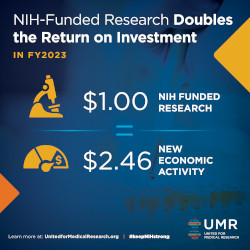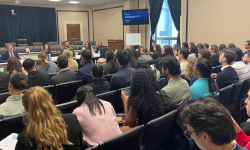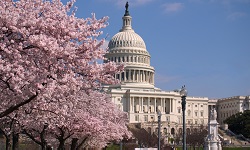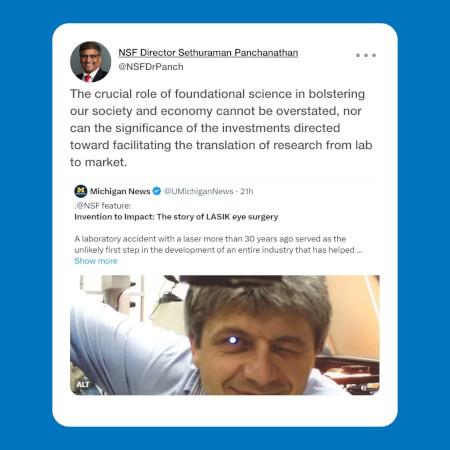 New Report Finds NIH Research Funding Supports Jobs, Fuels the U.S. Economy
New Report Finds NIH Research Funding Supports Jobs, Fuels the U.S. Economy
Every $1 spent by the National Institutes of Health in research funding in FY23 generated $2.46 of economic activity, says a new report by United for Medical Research on the “NIH’s Role in Sustaining the U.S. Economy.” UMR (of which AAU is a founding member) found that, in FY23, the NIH “awarded $37.81 billion in extramural research funding to researchers in all 50 states and the District of Columbia,” and that “this funding directly and indirectly supported 412,041 jobs and produced $92.89 billion in new economic activity nationwide.”
The NIH is the federal government’s medical research agency; biomedical and health research funded by the NIH through its 27 institutes and centers has led to countless discoveries and innovations that have improved the health of all Americans. UMR’s report underscores the importance of increasing funding for the NIH.
UMR also released updated state-level data on NIH’s economic impact. The coalition explained: “As NIH funding is awarded to researchers in individual states, that funding supports employment and the purchase of research-related goods, services, and materials. The income generated from these jobs and purchases cycles through the economy to produce new economic activity.”
Sen. Shelley Moore Capito (R-WV), who knows first-hand the importance of NIH funding, recently advocated for continued investment in the agency in an op-ed. “While the impact of NIH funding is important to every state, it is especially important in rural states like West Virginia, where the population and economy is smaller and there are fewer organizations conducting biomedical research,” she wrote.
 AAU Co-Sponsored Hill Briefing Highlights Importance of Federal Student Aid
AAU Co-Sponsored Hill Briefing Highlights Importance of Federal Student Aid
The Student Aid Alliance, a coalition of more than 40 higher education organizations, recently held a briefing on Capitol Hill to remind policymakers about how crucial federal student aid is to millions of American students and their families. AAU is on the Student Aid Alliance’s steering committee and helped organize and plan the event.
The “Student Aid 101” briefing highlighted the various types of federal aid programs authorized by the Higher Education Act of 1965 to help students and their families gain access to and afford a postsecondary education. These include Pell Grants; the TRIO, GEAR UP, and SEOG programs; and Federal Work-Study programs.
During the briefing, advocates as well as students from public, private, and community colleges testified about how access to federal student aid made their choice to attend college easier. National Association of Student Financial Aid Administrators Government Relations and Policy Associate Nalia Medina, for example, spoke about how federal student aid helped her earn both a bachelor’s and a master’s degree from George Washington University. “Without federal aid, I would not have been able to attend my dream school and I wouldn’t be where I am today,” she said. Many speakers also mentioned their immigrant backgrounds and how federal student aid helped them be the first in their families to attend college.
Speakers also called on Congress to double the Pell Grant, which is specially designed to help low- and middle-income Americans afford a college education. The annual maximum Pell Grant award currently stands at $7,395; AAU is a proud supporter of the #DoublePell campaign, which seeks to increase the maximum Pell award to $13,000 as an effective, targeted way to help make college more affordable.
 Final FY24 Funding Package Contains Mostly Flat Funding for Student Aid Programs, Scientific Research
Final FY24 Funding Package Contains Mostly Flat Funding for Student Aid Programs, Scientific Research
Earlier this month, President Biden signed a $1.2 trillion “minibus” funding package (H.R. 2882), bringing Congress’ six-month endeavor to pass FY24 funding to a close.
The package provides $79.1 billion in funding for the Department of Education (a $500 million decrease from FY23), including $24.6 billion for federal student aid programs. It keeps the annual maximum Pell Grant award the same as FY23, at $7,395. It also provides $3.3 billion for higher education programs, $1.19 billion for federal TRIO programs (same as FY23), and $793.1 million for the Institute of Education Sciences (a $14.5 million, or 2%, decrease from FY23).
The bill also includes $47.08 billion in funding for the National Institutes of Health and $1.5 billion for the Advanced Research Projects Agency – Health. While the bill provides $300 million in new funding for the NIH, it constitutes an overall $378 million cut to the agency’s base budget due to scheduled reductions in funding from the 21st Century Cures Act. The Agriculture and Food Research Initiative received $445.2 million in funding (a $9.8 million, or 2%, decrease from FY23).
AAU released a statement expressing disappointment regarding the final numbers for the NIH and static Pell Grant levels. “We hope to achieve increases in funding for NIH in FY25,” it noted.
 AAU Endorses Bicameral American Innovation Act
AAU Endorses Bicameral American Innovation Act
Earlier this month, Rep. Bill Foster (D-IL) and Sen. Dick Durbin (D-IL) introduced the American Innovation Act, “which would provide annual budget increases of five percent, plus inflation for cutting edge research at five federal research agencies,” including the National Science Foundation; the Department of Energy Office of Science; the Department of Defense science and technology programs; and NASA Science.
According to a press release from Rep. Foster’s office, “The legislation would position the U.S. as a leader in development and discovery for decades to come by creating steady, sustained funding for breakthrough research at America’s top research agencies.” AAU endorses the American Innovation Act.
 AAU, Associations Send Letter Opposing Changes to International Education and Foreign Language Programs
AAU, Associations Send Letter Opposing Changes to International Education and Foreign Language Programs
AAU joined the American Council on Education and 15 other higher education associations in sending a comment letter last week to the Department of Education expressing concerns about its proposed rule making changes to the regulations governing the National Resource Centers (NRC) program and the Foreign Language and Area Studies (FLAS) Fellowship program.
The programs, authorized by Title VI of the Higher Education Act of 1965, are the federal government’s “most comprehensive programs for developing national capacity in international and foreign language education,” the letter noted. The 30-day comment period, the associations said, did not provide stakeholders with enough time to review the “substantial and historic changes” included in the proposed rule.
The associations also expressed concern with proposed amendments that would require National Resource Centers to have a geographically defined focus, which would potentially eliminate some or all NRC international centers, and that would eliminate institutional payments as a component of FLAS fellowships, which could result in higher fees for students.
“We urge the department to make changes to these proposed rules before finalizing them and engage with stakeholders to update regulations regarding Title VI international programs,” the letter said.
News of Interest
The Hill: Congress Hands China Another Win – In an opinion essay, House Science Committee Ranking Member Zoe Lofgren (D-CA) argues that funding cuts for the National Science Foundation and the National Institute of Standards and Technology are “an unquestionable victory for our global competitors.” China in particular is increasing investments in research and development with the “clearly stated purpose” of “unseating the United States as the world’s leader in science and technology,” she writes.
Forbes: Dartmouth College Receives Mega Gift for Student Financial Aid – Dartmouth College is using a gift of more than $150 million to raise “its annual family income threshold for a ‘zero parent contribution’ for undergraduates from $65,000 with typical other assets to $125,000.” According to Dartmouth, this would make it “the most generous [family income] threshold in the nation.”
Daily Camera: CU Boulder Researchers Earn White House Recognition – A project led by University of Colorado Boulder researchers is among the winners of the White House Office of Science and Technology Policy’s Year of Open Science Recognition Challenge. The White House chose the project, called the Exchange for Local Observations and Knowledge of the Arctic, because of its “use of open science and relationship building that has advanced understanding of Arctic sciences, place-based knowledge and supported the self-determination of Arctic indigenous peoples.”
Los Angeles Times: In a Time of Rising Campus Antisemitism, USC Gives Highest Honor to Holocaust Survivors – Last week, the University of Southern California presented its highest honor – the gold University Medallion – to “victims of the Nazi regime who have taken part in preservation programs under the Shoah Foundation.” Founded by director Steven Spielberg three decades ago, the USC Shoah Foundation documents “audio-visual oral histories” of Holocaust survivors.
The Hill: Cardona Sends FAFSA Recommendations to States as Applications Lag Amid Multiple Problems – Education Secretary Miguel Cardona sent a letter asking state governors to motivate students to complete the Free Application for Federal Student Aid and to adjust their financial aid deadlines. The rocky FAFSA rollout thus far has led to significantly fewer students completing the application.
Featured Research

Methane Emissions from U.S. Oil and Gas Operations Cost the Nation $10 Billion Per Year
New Stanford University-led research shows that methane emissions in the United States are much higher than predicted by the government and that the emissions cost the nation $10 billion a year in “harm to the economy and human well-being.” Methane is “the main component of natural gas and the most abundant greenhouse gas after carbon dioxide.”

CTE Researchers Are One Step Closer to Diagnosing CTE During Life, Rather Than After Death
A new study from Boston University’s CTE Center is bringing doctors closer to diagnosing chronic traumatic encephalopathy or CTE in living patients. CTE is often seen in athletes who sustain frequent hits to the head and can currently only be formally diagnosed after death. The research shows a clear link between “the accumulation of a protein called p-tau in specific regions of the brain” and “the severity of a person’s cognitive and behavioral symptoms during their life.”
From Our Feeds

In 1993, a graduate student at the University of Michigan suffered an accidental laser injury to his eye. The accident led to the development of bladeless LASIK, which is now commonly used in corrective eye surgery worldwide.
The team of scientists who developed the technology initially received funding from the National Science Foundation and then later from the Department of Energy, the National Institutes of Health, and other agencies. “The path from lab to global use,” according to the NSF, “is an example of how federal support for basic and translational research produces new technologies with broad societal benefit.” The team that developed the technology won a Golden Goose Award in 2022.